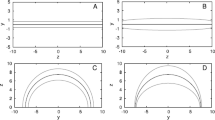Abstract
We perform numerical simulations of emerging flux loops in the solar convective envelope based on a weakly twisted thin flux tube model recently derived by Longcope and Klapper, generalizing the original formulation for the dynamics of untwisted thin flux tubes by Spruit. The generalized formulation includes the description of torsional Alfvén waves and takes into account the coupling of the writhing motion of the tube axis to the change in the flux tube twist based on the requirement of global helicity conservation of the closed thin flux tube. In this model, the twist of the thin flux tube is described by a quantity q defined as the angular rate of field-line rotation about the tube axis per unit length of the tube. We examine the evolution of twist along Ω-shaped emerging flux loops which are formed as a result of the non-linear growth of the Parker instability of toroidal magnetic flux tubes at the base of the solar convection zone. We find that: (1) In the northern hemisphere, a left-handed twist is generated in the flux tubes as a result of the right-handed tilt or writhe of the emerging loops induced by the Coriolis force. The generated twist increases with the latitude of emergence over the range from 0° to about 38° latitude, but then decreases when the emerging latitude exceeds 38°, because of a change in the preferred eruption pattern. The magnitude of the generated twist q is very small, ≲2×10−4 rad Mm−1, more than an order of magnitude smaller than the observed amplitude of twist (∼0.01 rad Mm−1) in solar active regions. (2) For a toroidal flux ring with a uniform initial twist q 0 along the ring, the twist amplitude |q| at the apex of the emerging loop decrease by a factor of about 0.67 because of the stretching of the loop, as it rises from the base of the convection zone to about 20 Mm below the photosphere, at which depth the flux tube can no longer be considered thin. However, because of the more rapid increase of the tube cross-sectional radius a with height, |qa|, which corresponds to the ratio between the azimuthal field to the axial field B θ/B l of the tube, increases by a factor of about 2.5 at the apex of the loop, as it rises over the same distance. (3) Because of the effect of the Coriolis force, the distribution of twist along the emerging loop is asymmetric between the leading (in the direction of rotation) and the following sides of the loop. Both |q| and |qa| are greater at the following side than the leading at any depth. Based on the evolution of twist along emerging flux loops, we discuss possible constraints on the twist q 0 of initial toroidal flux tubes at the base of the convection zone.
Similar content being viewed by others
References
Berger, M. A. and Field, G. B.: 1984, J. Fluid Mech. 147, 133.
Caligari, P., Moreno-Insertis, F., and Schüssler, M.: 1995, Astrophys. J. 441, 886.
Christensen-Dalsgaard, J., Proffitt, C. R., and Thompson, M. J.: 1993, Astron. Astrophys. 403, L75.
D'Silva, S. and Choudhuri, A. R.: 1993, Astron. Astrophys. 272, 621.
Fan, Y.: 2000, Astrophys. J., submitted.
Fan, Y. and Fisher, G. H.: 1996, Solar Phys. 166, 17.
Fan, Y., Fisher, G. H., and DeLuca, E. E.: 1993, Astrophys. J. 405, 852.
Fan, Y., Zweibel, E. G., and Lantz, S. R.: 1998, Astrophys. J. 493, 480.
Fan, Y., Zweibel, E. G., Linton, M. G., and Fisher, G. H.: 1999, Astrophys. J. 521, 460.
Ferriz-Mas, A., and Schüssler, M.: 1995, Geophys. Astrophys. Fluid Dynamics 81, 233.
Leka, K. D., Canfield, R. C., McClymont, A. N., and Van Driel Gesztelyi, L.: 1996, Astrophys. J. 462, 547.
Linton, M. G., Longcope, D. W., and Fisher, G. H.: 1996, Astrophys. J. 469, 954.
Longcope, D. W. and Fisher, G. H.: 1996, Astrophys. J. 458, 380.
Longcope, D. W. and Klapper, I.: 1997, Astrophys. J. 498, 443.
Longcope, D. W., Fisher, G. H., and Pevtsov, A. A.: 1998, Astrophys. J. 507, 417.
Moffatt, H. K. and Ricca, R. L.: 1992, Proc. R. Soc. London 439, 411.
Moreno-Insertis, F. and Emonet, T.: 1996, Astrophys. J. 472, L53.
Pevtsov, A. A., Canfield, R. C., and Metcalf, T. R.: 1995, Astrophys. J. 440, L109.
Parker, E. N.: 1979, Cosmical Magnetic Fields, Clarendon Press, Oxford, Chap. 9.
Spruit, H. C.: 1981, Astron. Astrophys. 98, 155.
Author information
Authors and Affiliations
Rights and permissions
About this article
Cite this article
Fan, Y., Gong, D. On the twist of emerging flux loops in the solar convection zone. Solar Physics 192, 141–157 (2000). https://doi.org/10.1023/A:1005260207672
Issue Date:
DOI: https://doi.org/10.1023/A:1005260207672




